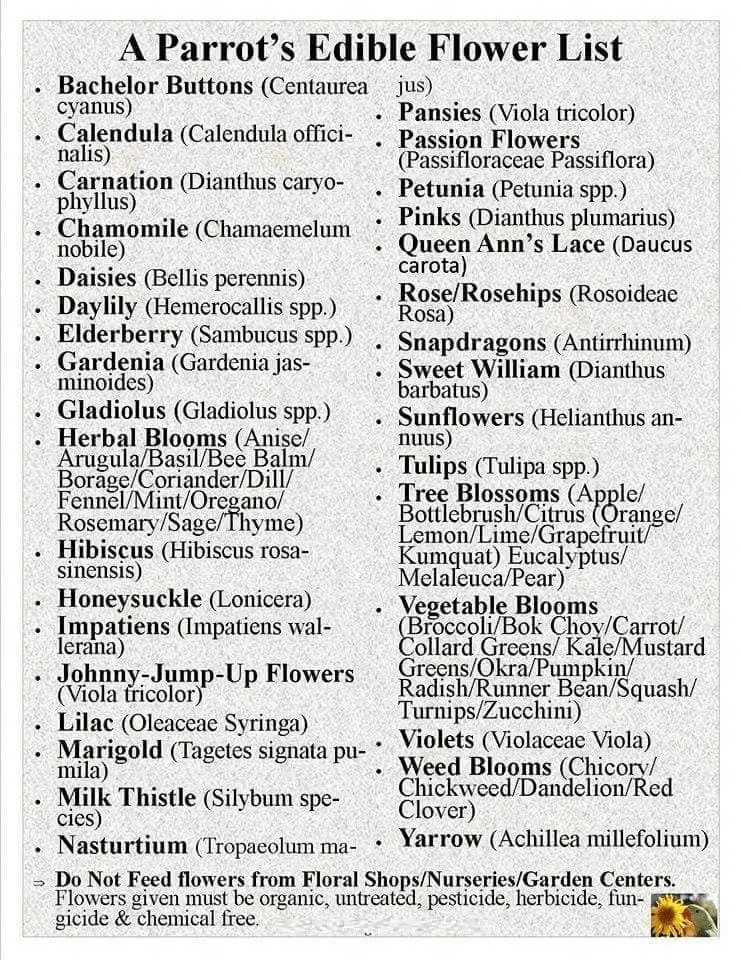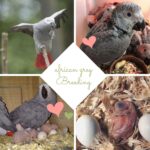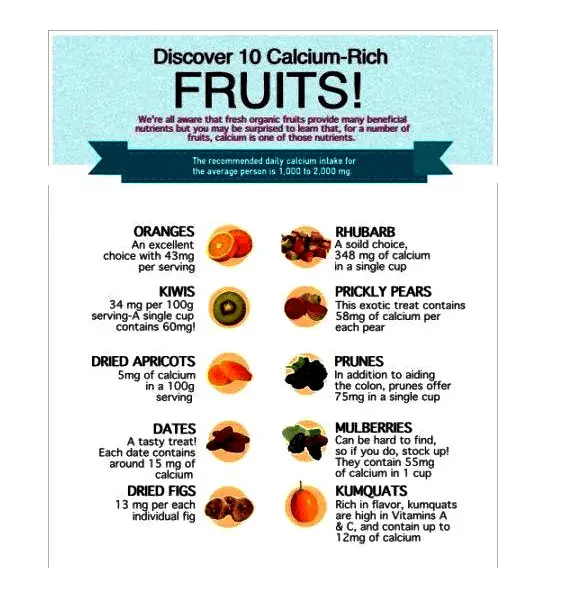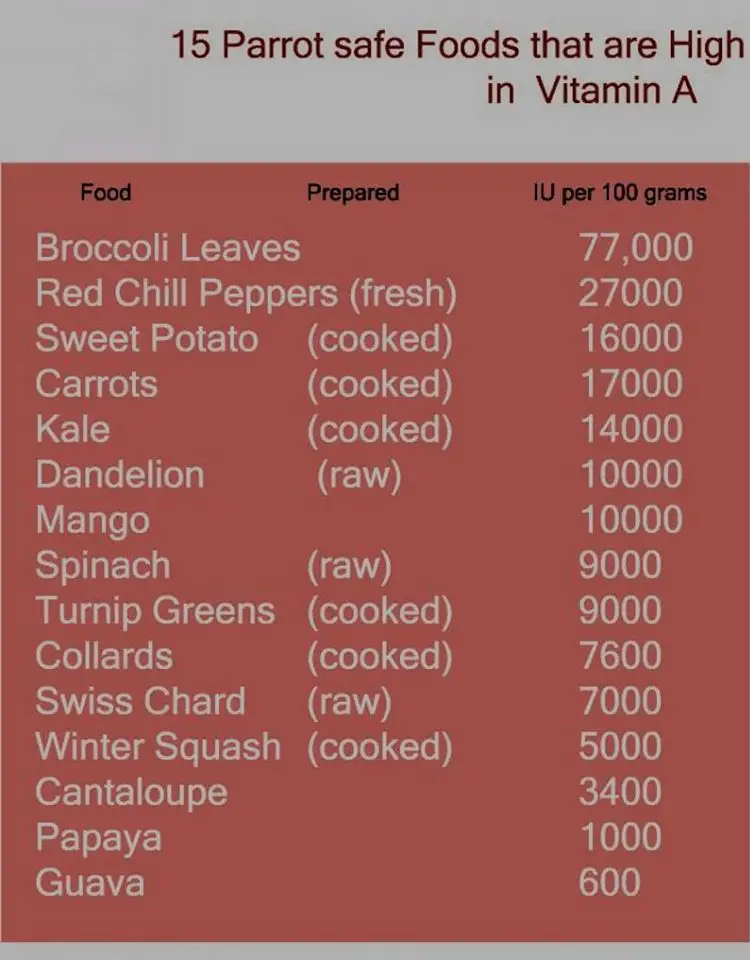
What does a parrot eat: Feed your parrot pellets, Including seeds. Give your parrot fruits and vegetables, and nuts, Add grains to your parrot’s diet, Add meat to your parrot diet. Give your parrot cool water. Avoid feeding your bird certain toxic foods.
Parrots are one of the most popular birds in homes around the world, these birds are pets much appreciated and respected by those who share their home with them. However, before adopting a parrot, it is essential that you consult the CITES convention to see if it is legal to have one in your country.
One of the most important aspects in the care of parrots is their diet. What do you know about the feeding of the parrot? Are you up to date on what a parrot eats? Establishing a menu that would adapt to all species of parrots is complicated… But, in this article What does a parrot eat? – Feeding the parrot of Animal Planet we will take the time it takes to solve all the doubts you may have about the feeding of the parrot, both in freedom and at home!
Caring for a parrot
If you have a parrot as a pet, you will have to follow a whole series of rules in order to make it happy. The first, and the main, is to ensure that he lives in a clean environment. To do this, we recommend that you daily clean its cage (which must fill a series of prerequisites) or the space where you keep your pet, as well as its perch and toys… In the same way, it is absolutely essential that you make a blunder to the hygiene of your pet, which will have to be groomed and dewormed.
It is essential that you always keep an eye on the condition of your parrot’s beak, as it will grow throughout the life of the parrot. If it cannot be used naturally, it may need to be polished and trimmed by your veterinarian. To promote the wear of the parrot’s beak and thus avoid excessive growth, it is recommended to leave in its cage elements and toys with which it can file its beak and claws. Some toys perfect for this are made of natural wood or cardboard.
Are parrots omnivorous?
Although it may seem incredible to you, parrots are omnivores, yes! although the parrot’s diet is basically based on the ingestion of plant-based foods, they can also ingest food of animal origin. Did you know that when we talk about “parrot”, this term encompasses a very large number of species (more than 350)each of which has its peculiarities that distinguish them from the others which obviously affect its diet?
But, in general, the vast majority of birds categorized as parrots, including inseparable (agapornis), cocoa and macaws, are omnivorous animals that consume very large amounts of fruits, vegetables, seeds as well as small invertebrates such as insects.
What does a free-roaming parrot eat?
Wild parrots inhabit regions with a warm climate throughout the Earth. They are found in Central and South America, Australia, South Asia, and Africa, where an immense variety of species adapted to diverse and varied habitats are concentrated. That is why the diet of the wild parrot will largely depend on the resources available in its environment, as we will see in continuation.
What does a wild parrot eat in freedom?
A free-roaming parrot will feed by adapting to the resources present in the environment where it lives. In general, they survive by ingesting:
- Fruits
- Flowers
- Fresh vegetables
- Seeds
- Cereals
- Insects
- Small invertebrates
Nevertheless, experts have spotted the preference they have for the ingestion of seeds and dried fruits, which turn out to be a real delight for them and, in addition, are very nutritious, giving them the necessary energy so that they can continue to look for food in nature.
What does a parrot eat in the jungle?
In the jungle, parrots have at their disposal a very wide variety of foods, since they have at their disposal the opportunity to consume a great diversity of plants. There are countless species of flowers, fruit trees, insects… which makes the diet of the jungle parrot stand out for its versatility.
Generally speaking, like other parrots, they feed on seeds and plants that they have at their disposal, as well as insects that have the misfortune to cross their path.
What does a baby parrot eat
As is the case for babies of almost all animal species, baby parrots need a specific and different diet than an adult of his species.
In the case of parrot babies, they can be fed with homemade fruit porridge, but only in an emergency. The most recommendable and healthy is to resort to preparations specifically developed to cover the energy needs of a young parrot.
These pastas contain a high percentage of protein, which is very important for the proper development of babies. You can buy them in veterinary centers or in shops specializing in animal products. On the bag you will find the way to prepare his meal, however, know that these meals are prepared by mixing the dough with tempered water previously boiled or purified (thus eliminating chlorine) and you must prepare the necessary rations for each meal that will be spaced about 2-3 hours apart.
In order to know how much you should give him at each meal, the best is to let yourself be guided by his own instinct, you will see if your parrot is hungry or not when you approach the dough to feed him. The dough should be creamy, neither too liquid nor too dense, because your young parrot will not be able to swallow it properly.
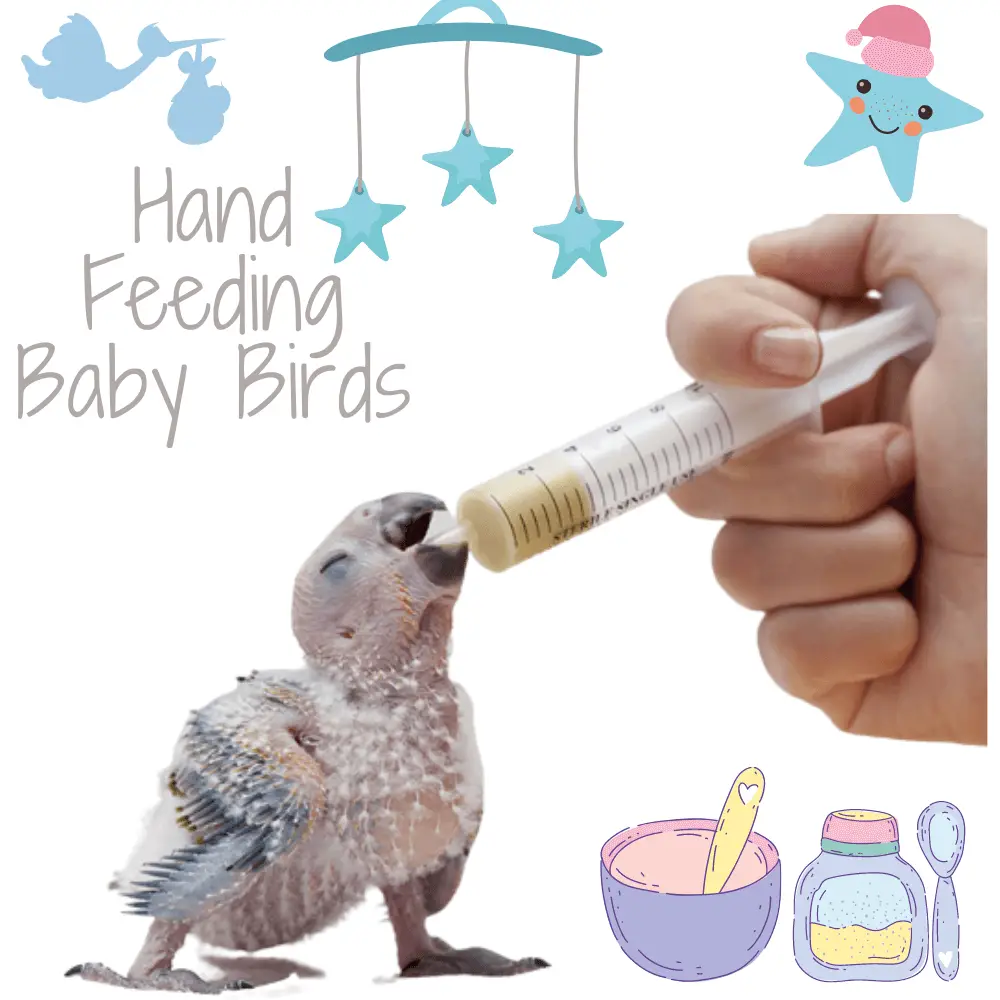
Feeding the domestic parrot
In the case of the domestic parrot, which does not include all species because a good number of parrot species are protected by law, and having one is strictly prohibited, you will have to take into account a whole series of data. At home, the best is to offer your parrot a controlled and very varied diet.
It must be balanced because the majority of parrots have a small tendency to eat a lot, which means that they end up being overweight and obese, two conditions that are extremely harmful to the health of your parrot. A parrot will gain weight when it has at its disposal a greater amount of food that they love (such as some dried fruits) and that it will not be able to stop eating.
Generally speaking, the daily diet of domestic parrots should be divided into the following way: 75% fruits and vegetables, 20% kibble and 5% treats, as you can see in this article in which we tell you about fruits and vegetables for parrots.
What does African Grey Parrot eat?
In the case of the Jaco parrot, the proportions will change slightly in accordance with the generics that we gave you in the previous paragraph, it is estimated that the ideal proportions of food are:
- 60% kibble
- 30% greens and fruits
- 10% seeds and legumes (preferably cooked or sprouted).
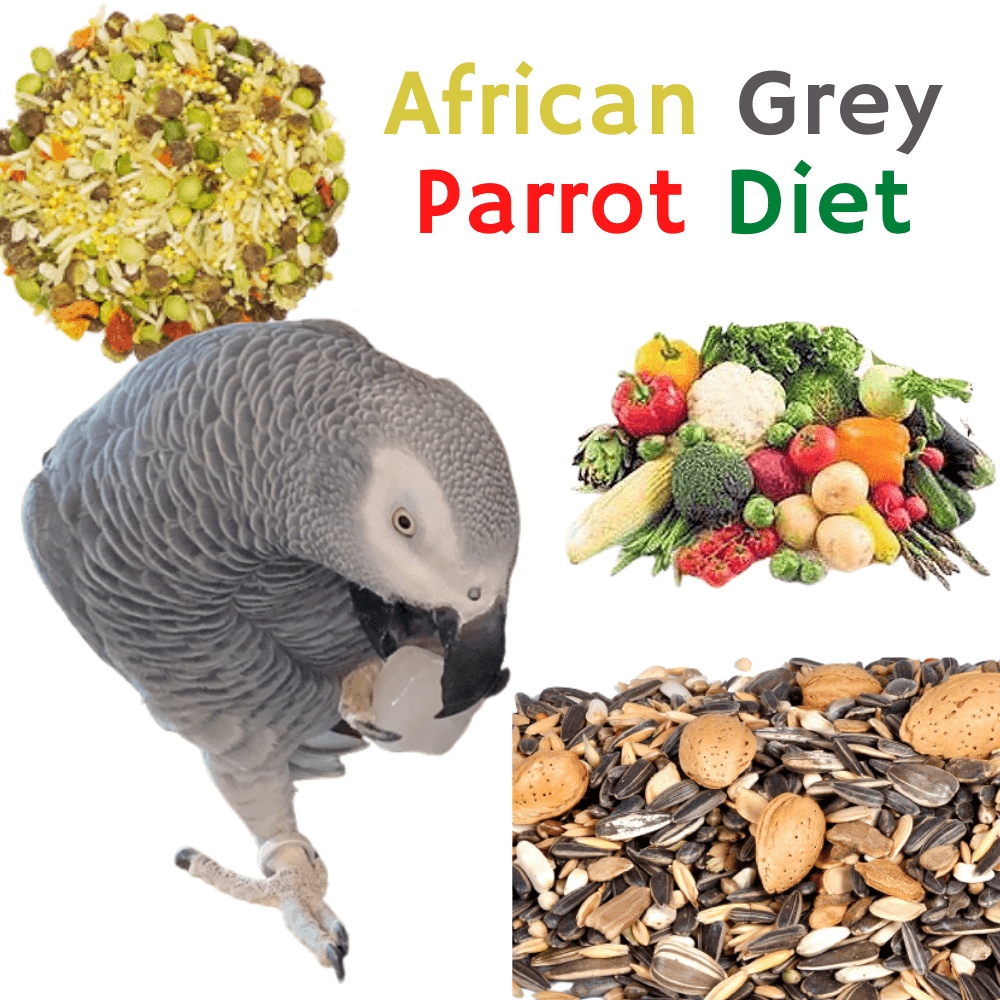
What eats a parakeet
Wavy budgies follow a diet similar to the one we proposed earlier. In captivity, that is, as a pet, experts recommend feeding them with seeds (such as Canary seed, millet or oats), to which you will add vegetables such as carrots, broccoli, cucumber orchard (very beneficial for wavy parakeets). You will have to complete their diet by giving them fruit more punctually.
In addition, it is worth highlighting the fact that in the case of wavy parakeets, grapefruit is toxic. Conversely, it is extremely recommended to give them baby paste at two specific times in their adult life: when temperatures cool down and when they will reproduce because in these moments of life they need a greater protein and energy intake.
What do small parrots eat?
What are small parrots? In this category, we find small parrots, such as inseparable (Agapornis) which measure barely 4 to 7 cm from head to tail for a weight of 50 grams. Another example of a small parrot is the Lori, the latter feed exclusively on nectar and pollen, so it follows a completely nectarivorous diet.
In captivity, these animals must be fed (apart from the Lori for which you will find specific preparations) with kibble specifically formulated for small parrots. In this case, will be indicated the amount to offer according to the size of the animal, logically, a small parrot will not have the same energy needs as a large parrot. But, in essence, the basis of their diet remains the same: seeds and plants.
What does a green parrot eat?
The green parakeet is one of the most common parrots in households, which is why it is important that you know its concrete nutritional needs. In fact, many experts defend the fact that feeding them with quality end-use products is more than enough, providing a small extra of minerals and vitamins with green leaf greens supplements, such as cabbage or Swiss chard, as well as occasionally fruits.
In this way, a good diet is obtained, similar to that which these animals have in freedom, even if in the freedom they feed on roots, seeds, and insects.
Prohibited feed for parrot
As we have said, the diet of parrots is very varied, which can include an immense diversity of foods. However, there are certain foods that you should never give to a parrot because they are potentially dangerous, even deadly, in certain quantities. Prohibited foods for all types of parrots are:
- Sodas
- Alcohol
- Juice
- Coffee
- Salt
- Cocoa or chocolate
- Sugar and sweets
- Dairy product
- Fish
- Meat
- Fried product
- Food containing colours or flavourings
- Preserves and spices
Knowing that their diet must be based on the most natural foods possible, you will have easily deduced that the products we have just mentioned are harmful to them, but there are other foods that may seem good but are not at all:
- Garlic
- Onion
- Eggplant
- Lawyer
- Raw tubers
- Fruit seeds, such as those of pears or apples
For more information, you can check out this other AnimalWised article in which we tell you about the forbidden parrot foods so that you know exactly what they can and cannot eat.
If you want to read more articles similar to What does a parrot eat? – Feeding the parrot, we recommend that you consult the Home Feeding section.
Toxicity of Apple Seeds and other fruit seeds that originate from the flower:
Apple seeds do contain small amounts of cyanide and other pesticides want to spray the flowers that formed the seeds, which may be lethal poisonous, you’re shielded from the toxin by the hard seed coating, but once the hard coating is broken the poison goes to the bloodstream.
What do parrots eat
SOURCE:The Zoological World
Dates are the Healthiest Fruit and a Natural Cure for parrots:
Dates are the foremost nutritious and also advantageous natural products and therefore the rundown of manners by (which they enhance well-being is really interminable). they need an excellent dietary profile,100 grams [3,5 oz} serving gives:
- 2 grams of protein
- 7 grams of fiber
- 75 grams of carbs
- 277 calories
- 12 of the RDI of vitamin B6
- 5% of the RDI of iron
- 18% of the RDI of copper
- 14% of the RDI of magnesium
- 20% of the RDI of potassium
Parrot Nutrition
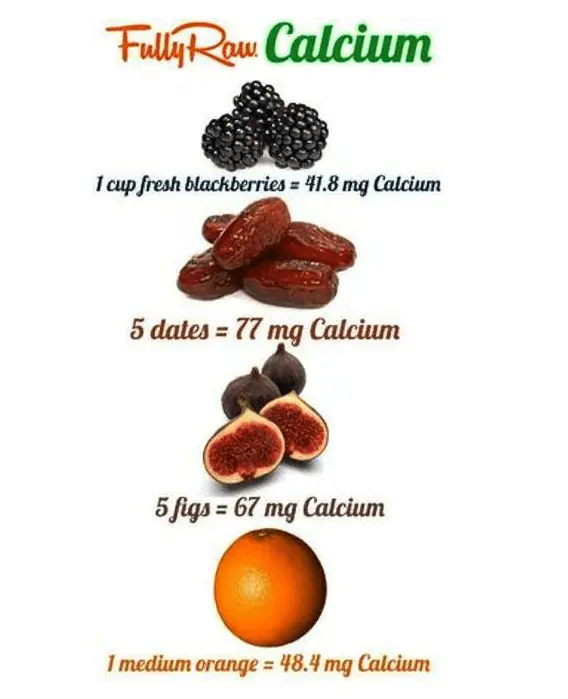
The dates are an upscale source of antioxidants, and therefore the most potent ones are those below, the Healthline concluded:
Phenolic Acid — Known for its mitigating properties, phenolic corrosive may help bring down the danger of malignant growth and coronary illness.
Carotenoids — Carotenoids are demonstrated to advance heart wellbeing and should likewise diminish the danger of eye-related scatters, for instance, degeneration.
Flavonoids — Flavonoids are incredible cell reinforcements that will help lessen irritation and are contemplated for his or her capability to diminish the danger of diabetes, Alzheimer’s malady, and particular kinds of malignant growth.
And also below within the article, you’ll examine a number of the most and most vital health benefits that these fruits offer:
Dates contain zeaxanthin and lutein that enhance the condition of the retina and macula and during this way enhance vision and avoid age-related macular harm.
To help the charisma and enhance your sexual coexistence, absorb dates goat drain within the first a part of the day, mix in cardamom and nectar, and drink the blend.
Dates make a sentiment of totality and during this way help weight reduction.
To support heart well-being, splash dates medium-term, mix them toward the start of the day, and take this smoothie once each day.
Dates detoxify the body, mitigate clogging, quicken digestion, and enhance the state of the intestinal tract.
Being high in magnesium, (that enlarges veins), the dates bring down pulse.
Being one of the foremost extravagant iron sources, dates are fantastic within the treatment of weakness and lift the oxygen stream to the cerebrum.
Dates are brimming with fiber, in order that they enhance the stomach-related process and smother hunger.
Dates are plentiful in calcium which helps the intestinal verdure, and viably treats looseness of the bowels.
The high phosphorus content enhances the capacity of the cerebrum.
Dates are wealthy in potassium, which brings down the danger of stroke by 35% and also helps the capacity of the sensory system.
CITRUS
CITRUS GIVEN ONCE A WEEK DUE TO ACIDITY
Healthy food for parro
- TOMATO / TOMATOES
GIVE IN SMALL QUANTITY, JUST A LOT OF MADURO AND SWEET – GIVE ONLY IN SMALL QUANTITIES IF VERY RIPE, SOFT AND SWEET.
- Mushrooms/mushrooms
don’t give mushrooms to birds – don’t give mushrooms to birth.
- Red / red cabbage
usually give in the salad, just great quality, succulent and sweet, like it a lot – I give in the Salado only when it’s of high quality, sweet.
- CHICKEN / CHICKEN
SERVE CRUSHED, CHICKENS THAT INCLUDE THE BONE THAT IS MACIO AND HAS CALCIO – SERVE CRUSHED, CHICKEN NECKS COOKED INCLUDING THE BONE.
- EGGS / EGGS
SERVE BOOKED EGGS WITH THE HOUSE, TOTALLY TRIGGERED INCLUDING THE HOUSE – SERVE BOILED / COOKED EGGS MESHED WITH SHELL INCLUDED.
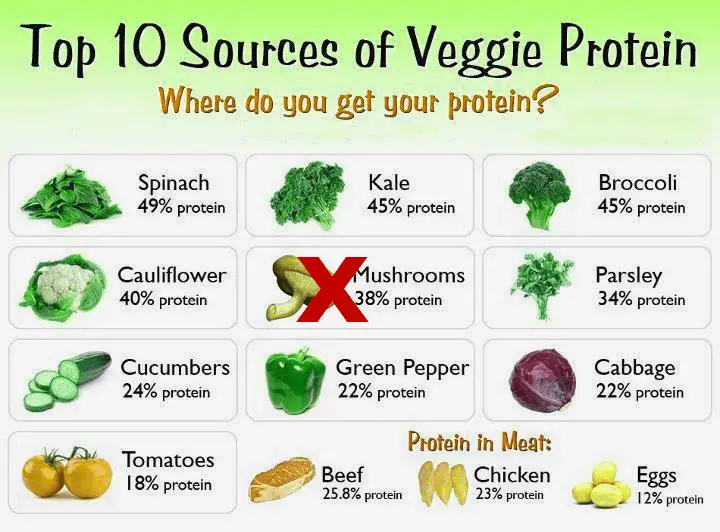
Healthy food for parrot
PROTEIN
PROTEIN SOURCES FOR PARROT:
It is important that birds receive many sources of protein. Amino acids and proteins built from them are necessary for the production of feathers, bones, hormones, muscles, and enzymes. Protein is also used as an important source of energy.
The seed is an excellent source of plant protein in bird feeding, which can and should be complemented by the insertion of spinach, broccoli, bean sprouts, cauliflower, corn, almonds among other elements.
One of the bird species that need more protein and calcium than the other species are African Grey Parrots.
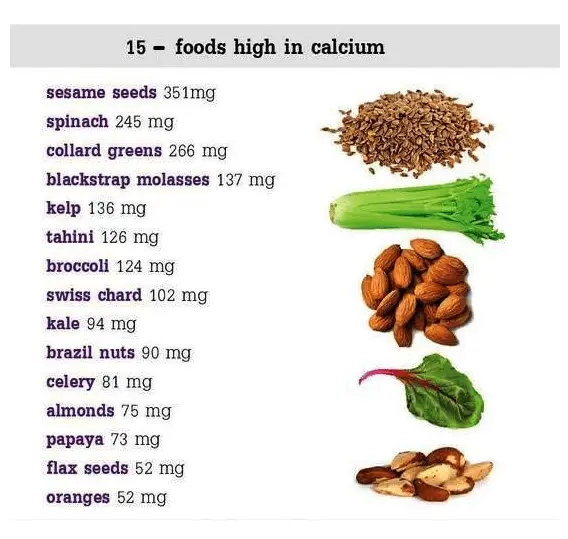
Healthy foods for parrot
Beets
Benefits of Beets for parrot
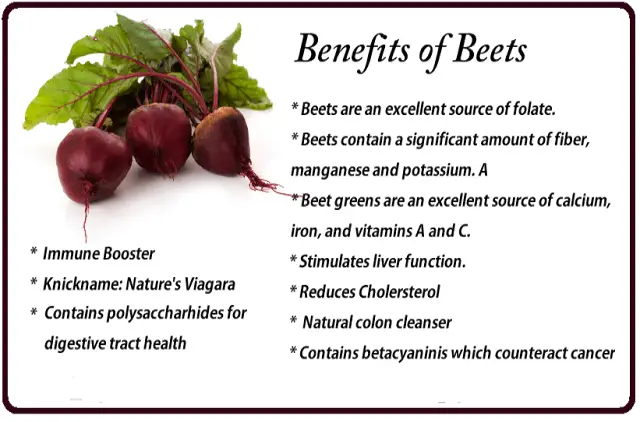
Healthy foods for parrots
Pumpkin is a wonderful botanical fruit! High in beta-carotene, the precursor to Vitamin A, a really good source of the B vitamins minus Vitamin B12, and not too shabby in potassium and naturally occurring Vitamin K! The dietary fiber (carbohydrate) pumpkin contains is mostly starchy fiber and some pectin. Almost all of the cellulose is external (skin), although some are on the inside (the stringy part). The seeds of the pumpkin contain about 8.5% protein when served naturally dried or dehydrated without heat. And the seeds are a great source of magnesium, phosphorous, potassium, and zinc. The seeds are also a great source of vitamins B, E, and K. When it comes to all of the nutritional fatty acids, saturated, monounsaturated, and polyunsaturated the seeds take it well over the pumpkin meat itself; the seeds contain all of the dietary fats and no cholesterol.
Don’t overlook pumpkin leaves, they are packed with nutrition as well. As long as you serve the youngest and tender leaves they are perfectly fine for your bird’s health and digestive tract. The leaves are a pretty good source of all of the main trace minerals as well as the fat-soluble vitamin-like Vitamin A and water-soluble vitamins such as the Bs and C. They also contribute some essential fatty acids.
You might even want to consider offering up flowers from your pumpkin patch. The flowers do contain trace amounts of Vitamin A and the fiber in flowers consists of pectin, that fiber that gently flushes the digestive tract.
If you have a feather destroyer you will want to avoid this autumn food together. Pumpkin ranks “low” in salicylates and also “low” in histamines. One might think this is a good thing for birds who are triggered by these two naturally occurring food chemical constituents – not so. In order to ensure our birds are not triggered by these constituents, we must find foods that are “negligible”, meaning that they are almost immeasurable in the individual food.
On a chart, they may have a “very low” to “none” rating. Unfortunately, pumpkin, like so many other squashes have just enough to trigger our super sensitive feather destroying birds. The same holds true for the seeds inside; they are high in salicylates and histamine. Unfortunately cooking the “meat” and/or the seeds doesn’t reduce or remove these constituents, so there you have the downside to the pumpkin. If you have a feather destroyer it’s “no great pumpkin” for your bird at least until your bird goes through complete detox and replenishment of healthy gut flora in its digestive tract!
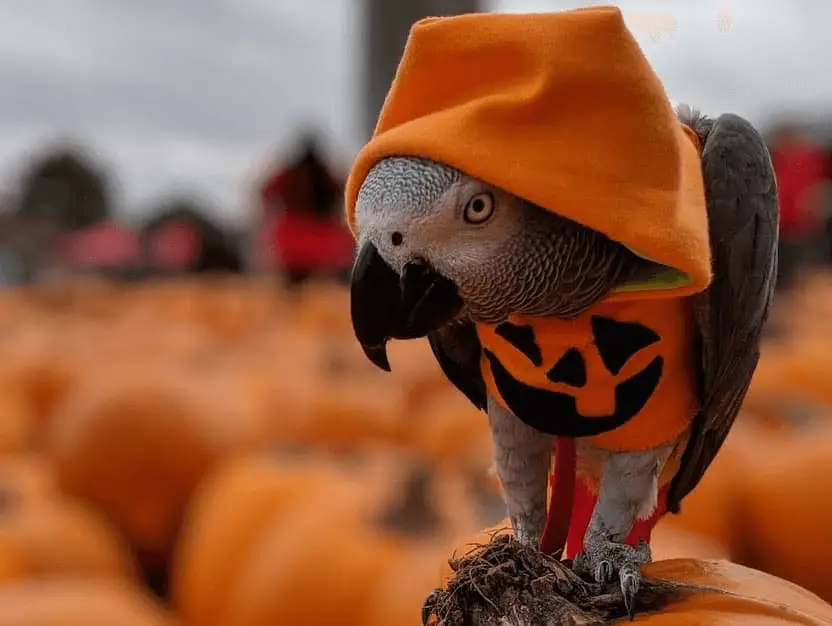
Healthy food for parrots
TURNIP GREENS
Benefits of TURNIP GREENS for parrot
— Key Source of Vitamin K
Turnip greens, also known as turnip tops, are one of those dark leafy greens that are highly recommended because they pack a lot of vitamins and minerals into the high fiber, low fat, low-calorie package. Turnip greens actually contain more cancer-fighting phytonutrients than their more popular cousin, broccoli. Turnip greens are an exceptional source of natural vitamin K, the blood-clotting vitamin. They also contain several other vitamins, including vitamins A, C, and several B vitamins, in addition to being an excellent source of calcium.
Vitamin K appears to be more important in maintaining healthy bones than we once realized, so turnip tops, as a rich source of both K and calcium, appear to be great food for strong bones.
Probably any bird would benefit from having some chopped turnip tops in the food mix, but this green is particularly important for Conures and Mini Macaws, who may be at risk for a disease caused by Conure Bleeding Syndrome, which can be fatal. In a bleeding emergency, an avian vet must treat the bird immediately with injectable vitamin K, but we Conure and Mini Macaw owners should try to prevent the illness altogether, by feeding a diet with plenty of natural vitamin K.

Properties:
Amino Acids: Rich in tryptophan, an essential amino acid thought to be linked to healthy sleep.
Vitamins: K, A, C, folate, E, B6, B2, B1, B5
Minerals: Manganese, calcium, copper, potassium, magnesium, iron, phosphorus.
Turnip greens, also known as turnip tops, are one of those dark leafy greens that are highly recommended because they pack a lot of vitamins and minerals into the high fiber, low fat, low-calorie package. Turnip greens actually contain more cancer-fighting phytonutrients than their more popular cousin, broccoli. Turnip greens are an exceptional source of natural vitamin K, the blood-clotting vitamin. They also contain several other vitamins, including vitamins A, C, and several B vitamins, in addition to being an excellent source of calcium. According to the U.S. Department of Agriculture, vitamin K appears to be more important in maintaining healthy bones than we once realized, so turnip tops, as a rich source of both K and calcium, appear to be great food for strong bones.
Probably any bird would benefit from having some chopped turnip tops in the food mix, but this green is particularly important for Conures and Mini Macaws, who may be at risk for a disease caused by Conure Bleeding Syndrome, which can be fatal. In a bleeding emergency, an avian vet must treat the bird immediately with injectable vitamin K, but Conure and Mini Macaw owners should try to prevent the illness altogether, by feeding a diet with plenty of natural vitamin K.

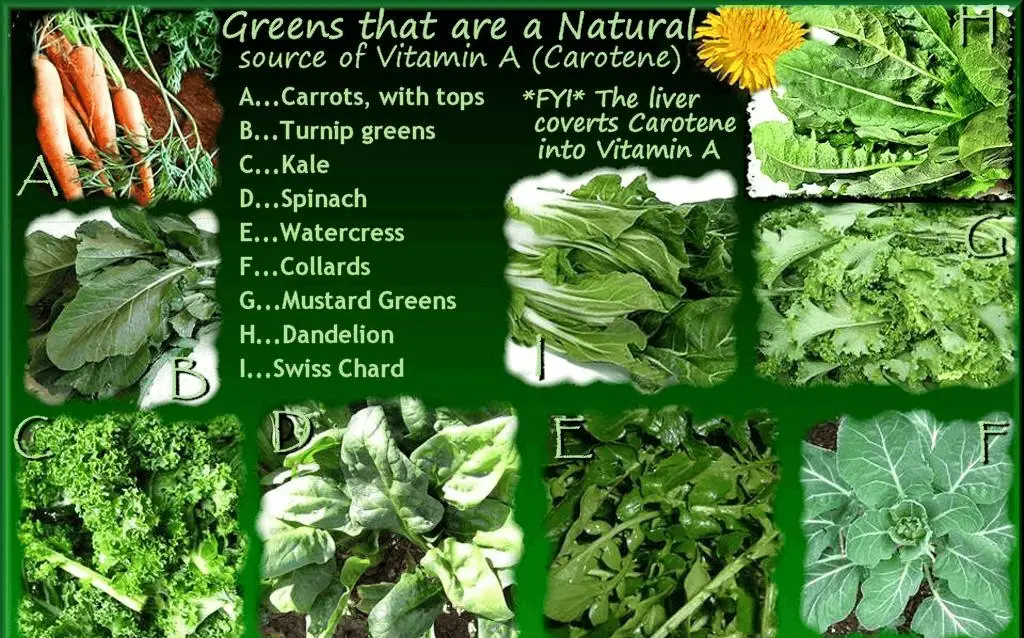

Vitamin for parrot
Vitamin A Deficiency in Parrots
Vitamin A
This is the most commonly deficient nutrient in a pet bird’s diet. Unfortunately, it is one of the most commonly overlooked and undiagnosed. (It is especially common in parrot fed on diets consisting mostly of nuts and seeds). Vitamin A is fat-soluble and is responsible for growth and development, hormone production, immune system response, the formation of epithelial, vascular, and mucous membranes. It is also responsible for good vision and it is responsible for the yellow and red pigmentation that most parrot owners love. (parrot Vitamin Deficiency Symptoms White spots around the beak which then turn into abscesses). Other symptoms include sneezing, wheezing breathing, crusty nostrils, slimy mouths, diarrhea, dull feathers, restlessness, lethargy, loss of appetite, and gagging sounds.
Effects of Vitamin A deficiency:
Disorders and failures in the three essential body systems; respiratory, digestive, and reproductive systems. Disorders of these systems usually lead to shorter lifespans if not death.
How to treat vitamin A deficiency:
The best way to get the parrot vitamins is = [through bird vitamin supplements]. The best is beta-carotene which the bird can easily store and convert into Vitamin A as needed. Increase the intake of fruits and foods rich in Vitamin A or Vitamin A precursors (e.g. beta-carotene) such as spinach, egg yolks, carrots, papaya, broccoli leaves, sweet potato, cantaloupe, and collards.
Don’t Let Your Parrot Overheat:
Sunshine or UV Lighting helps insure proper vitamin D3 and Calcium levels in parrots.
Vitamin D
D is processed from exposure to the (UV) content of sunlight. However, domesticated birds are kept indoors most of the time leading to a deficiency. Some parrot parents assume that exposing their parrots to the sunlight by placing them next to the window is enough. This is incorrect because windows block UV light and even when open, the amount of sunlight passing through is too little.
Furthermore, the sunlight that helps to produce Vitamin D is also important for ensuring that the bird’s sleep cycles stay regular. This means that part of the reason your parrot may refuse to stop shrieking at night is that by failing to produce his/her vitamin D in the sunlight is interfering with his/her sleep patterns.
Bird Vitamin D Deficiency Symptoms:
Easily fractured bones may be accompanied by a significant decrease in weight indicating a decrease in overall bone strength.
Physical abnormalities -overgrown or soft beak, bent keels, and splayed legs.
Low calcium levels caused by Vitamin D deficiency also may result in increased susceptibility to a wide range of cancers as well as Conure Bleeding Syndrome.
How to treat deficiency:
A great preventative measure is a good diet from the start.
However, where deficiency has occurred you will need to buy the vitamins in supplement form as well as install a UV light to ensure that intake and recovery are as speedy as possible.
Calcium
Calcium is directly tied to Vitamin D and the deficiency goes hand in hand. It is important that you know that specific types of parrots like the African Grey are quite easily susceptible to Calcium deficiency and require supplementation in their diets. Calcium is needed for blood clotting, muscle function, and the formation of eggshells, bones, and attachment of feathers.
Furthermore, calcium is an ingredient of certain neurotransmitters meaning that it has a direct effect on the mood of the parrot especially when a deficiency occurs.
Symptoms of calcium deficiency in parrots:
Due to the direct linkage with Vitamin D and especially activated Vitamin D3, the symptoms of a deficiency are practically the same. However, it is important to note that calcium is involved in the regulation of manganese intake.
How to treat deficiency:
Calcium deficiency is not only caused by lack of sunlight but also by poor nutritional
However, treating this deficiency is not as simple as just providing mineral supplements in the form of pellets.
Mineral elements such as calcium and phosphorous only work well when they are in specific ratios in the body. For example, calcium needs to be twice as much as phosphorous.
Additionally, mineral elements are toxic in quantities larger than traces.
Lastly, prevent this from happening again by ensuring that the parrot gets adequate time in the sun.
Other vitamins
B, E, K, C Vitamins are usually categorized into water and fat-soluble vitamins. Fat-soluble ones are stored in the bird’s body’s fat and can cause toxicity in high amounts while water-soluble ones are passed out in the urine. Fat-soluble vitamins are A, D, E, and K while water-soluble vitamins are thiamin (B1), riboflavin (B2), niacin, pyridoxine (B6), pantothenic acid, biotin, folic acid, vitamin B12, choline, and vitamin C (ascorbic acid).
A quick overview of why each of these is needed:
Thiamin – transmission in the nervous system; deficiency causes restlessness, feather picking, shrieking, and seizures.
Niacin – energy production and tissue formation; deficiency causes neurological symptoms and poor growth.
Pyridoxine – amino acid utilization and antibody formation; deficiency causes immune dysfunction.
Pantothenic acid and biotin – metabolic reactions, enzyme formation, and carbon dioxide metabolism; deficiency cause metabolic system disorders.
Folic acid – production of amino acids and antibodies; deficiency causes immune disorders.
B12 – important for metabolic processes and formation of proteins, nucleic acid, carbohydrates, and fat; deficiency leads to metabolic disruption and death.
Ascorbic acid – enzymatic reactions for maintaining collagen and elastin in walls of blood vessels. How to treat deficiencies in parrots.
Deficiencies of important vitamins can only be properly diagnosed by an avian veterinarian. Such specialists should also provide information on the supplements to be used and the dosage levels.
Amino acids
Amino acids are the building blocks of proteins. These are an essential part of a healthy and nutritional bird diet. Amino acids and proteins are needed for feather, bone, muscle, enzyme, and hormone formation. Remember, proteins are the building blocks of muscle and are therefore needed at all stages of muscle formation. Additionally, deficiency in proteins can weaken certain parts of the bird’s body such as the wings. This can lead to temporary and in some cases permanent loss of flight abilities. How to treat deficiency Small live organisms, boiled eggs, and monkey biscuits are a great way to provide protein supplements. The case for pellets Just like children birds are picky eaters; they will selectively eat what they like the taste of and avoid what they do not enjoy.
Parrot Edible Flower List
